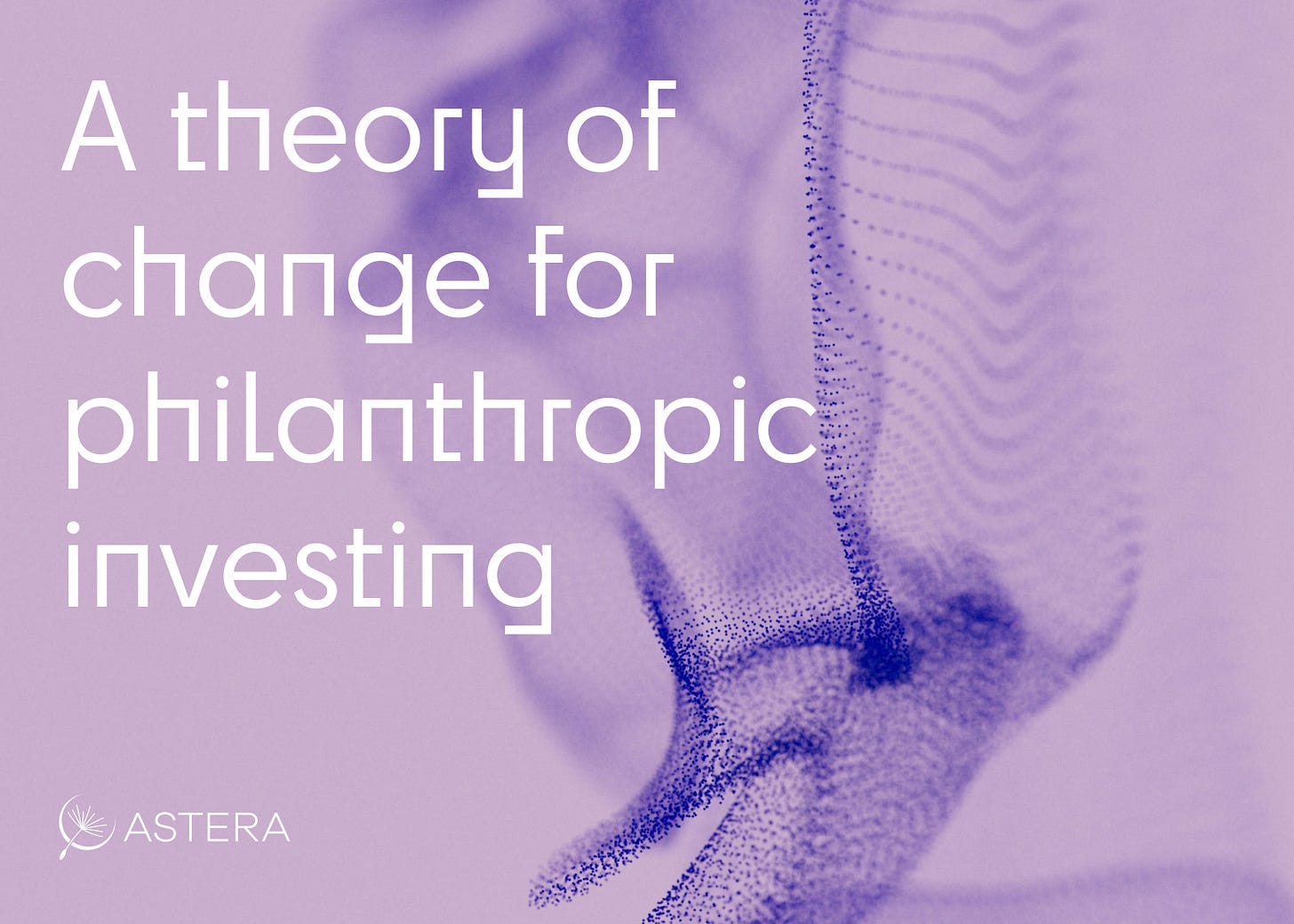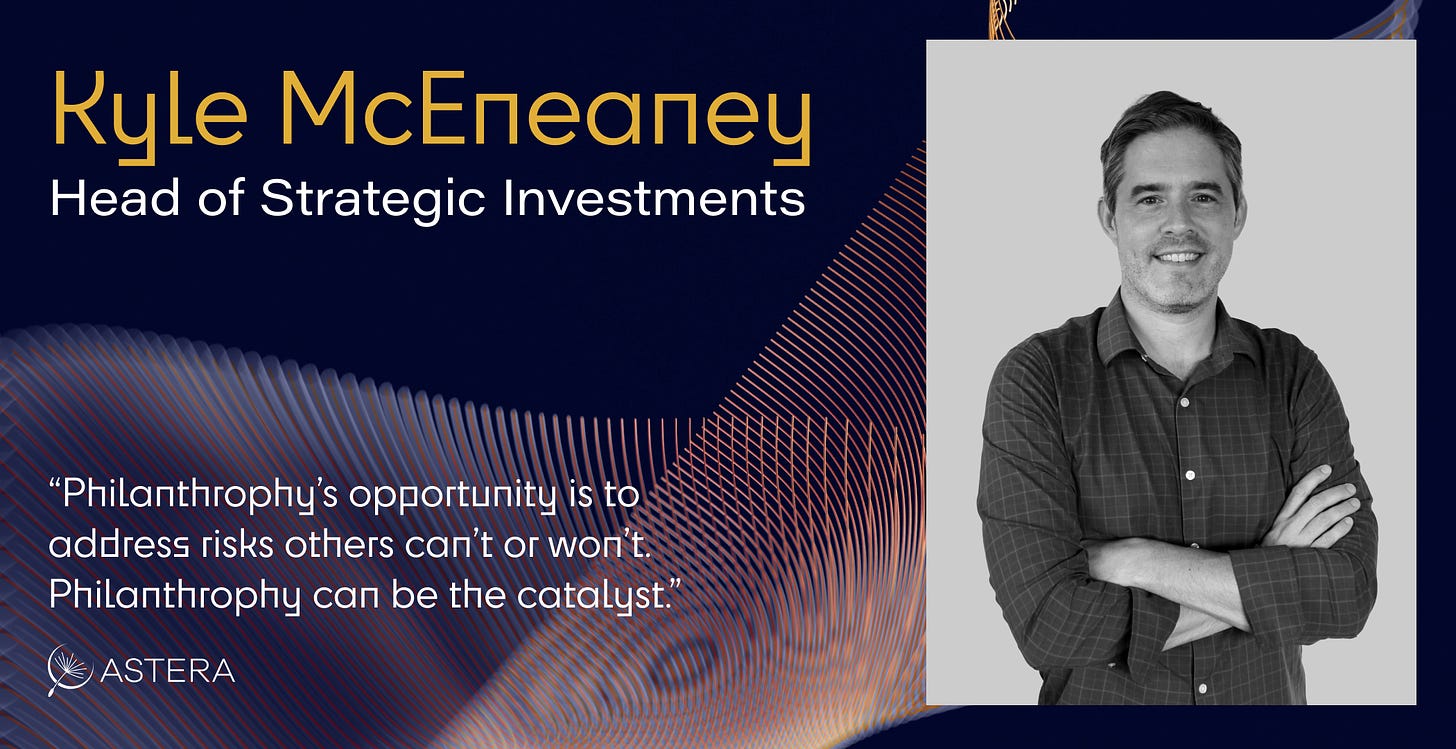A Theory of Change for Philanthropic Investing
Kyle McEneaney joins Astera as Head of Strategic Investments
Astera is a nonprofit institute dedicated to empowering visionary, high-leverage science and technology projects with the capacity to create transformative progress for human civilization. Kyle McEneaney joins Astera as our first Head of Strategic Investments to build our strategy for catalytic philanthropy in science and technology. Previously leading work in digital infrastructure and climate technology at Schmidt Futures, and with a background in deploying technology in emerging markets, Kyle brings a unique perspective to philanthropy and change to Astera. The post below is Kyle’s perspective on philanthropic investing and why it matters for Astera’s mission.
We have two very good engines for scaling and distributing “good things” in the world (however we define those things): markets and governments. If those “good things” can generate equivalent value for a lower cost as compared to alternatives—or, better yet, create new value—markets will deploy them widely and quickly. And for their part, governments can organize and shape markets, operate at large scale, and allocate resources to things that create value for society, but insufficient capturable value for markets (e.g. health for lower-income populations; last-mile postal or internet service, or electricity; basic research; etc).
But markets and governments have some limitations that can prevent them from scaling good things well, or quickly. Market actors are constrained by time horizons, opportunity costs, and economic incentive structures, and do not necessarily allocate to “good” things. And governments are slow to act, risk averse, and constrained by bureaucracy and political incentive structures. This is a very compelling opportunity for philanthropy: to mobilize the far greater resources in markets and government toward scaling *good things* by altering incentives and/or filling gaps those other actors by their nature cannot.
To illustrate, consider venture capital. VC has gotten very, very good at scaling software, and has expanded dramatically over the digital (and particularly mobile) era. VC and software have essentially co-evolved—the milestones software companies need to meet to obtain VC funding are well known; the instruments of investment are increasingly standardized; and—generally—VC return objectives and power law strategy can only accommodate companies with software-style growth profiles (high) and capital asset requirements (low). But, many technologies we know we want or need don’t fit this profile. Their intellectual property may not be easily capturable. They might require years of development and hundreds of millions of dollars of physical plant just to know if their technology works at scale. Their returns at maturity might look more like utilities than unicorns. We see this problem now among energy transition technologies—long-duration energy storage, carbon dioxide removal, low carbon cement and steel, and others. They aren’t getting deployed at commercial scale because they aren’t a good fit for venture capital, but are too early/risky for either government or project or corporate finance.
Philanthropy is uniquely suited to address market or government failures like these because of its flexibility with respect to time and outcomes. Philanthropy can both act quicker and also take a longer view than those institutions. And, without a requirement to generate a specific economic return on a specific timeframe, it can take risks others cannot.
The strategy of mobilizing those two engines for scale is also highly efficient. Philanthropy will never have more resources than governments or markets. Focusing on things those institutions can’t or won’t do well helps avoid duplication of effort and waste of scarce, flexible philanthropic capital. And, given the size and force of those institutions, simply opposing them is a Sisyphean task that is unlikely to result in lasting change.
It’s important to note that philanthropy’s flexibility is both a strength and a weaknes—without a profit or revenue imperative, philanthropy has trouble measuring progress and success, and lacks strong incentives to be efficient. And frequently, the social sector does not understand commercial or government actors well enough to anticipate how they should fit into the desired outcomes sought.
There may not be a perfect formula, but I believe philanthropies that can overlay a scarcity mindset—which undergirds markets’ ability to innovate—on top of an abundance toolset—government’s power to scale—are positioned to outperform.
Philanthropy is uniquely suited to address market or government failures because of its flexibility with respect to time and outcomes.
So, why should philanthropies invest? If philanthropy’s advantage is that it can address risks others can’t or won’t (because they can’t price the risk or the return, or capture value on a particular time frame, etc.), then one of philanthropy’s main challenges is how to introduce and promote discipline and efficiency as risks are retired and initiatives become ready for markets or governments to scale them.
Investing can serve as a sort of price discovery mechanism to resolve this tension. Putting a “price” on philanthropic support – making a grant recoverable upon certain milestones; lending on favorable terms, or to borrowers with weak credit; sharing in underlying economics if a philanthropic initiative turns out to be economically viable; etc.—helps minimize adverse behavior (people undervalue and overuse “free” things), provides a signal of utility (people don’t “pay” for things they don’t need), and creates a source of sustainability (any returns generated can be recycled into new philanthropic initiatives).
When it comes to choosing where to invest, a framework I like to use to help select specific problems and identify solutions is the “3 Cs”—consequential (does it matter at scale?), countercyclical (is it neglected by others because it is hard, boring, or disfavored?), and catalytic (will our action enable others to act on the problem?). In addressing these questions, we generate answers to other critical concerns: is this worth the opportunity cost? Who else is focused on this problem, what are they doing, is it working, and if not, why not?
As we build a strategy for impact investing at Astera, we’ll have more to say about specific ways we will invest, but for now I’m interested in talking to innovators from across science and technology with transformative “3C” ideas, and also to coordinate and collaborate with others in philanthropy who want to explore new approaches to scale emerging science and technology.
There are so many opportunities for intervention in how emerging science and technology is funded and translated into impact. That’s not to say that the system of how we generate ideas and translate science is fundamentally broken—in fact, it works very well!—but we are leaving lots of value on the table, both within and alongside the existing system, and in areas which that system isn’t set up to observe or develop. A new, independent institution like Astera can have an unreasonably outsized impact here—and that’s what we are planning to do!





Love these insights. Hope he can keep writing as things progress.